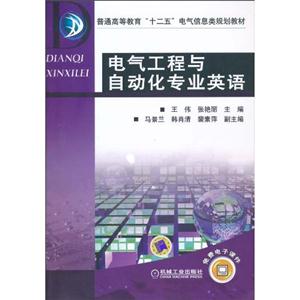-
>
公路车宝典(ZINN的公路车维修与保养秘籍)
-
>
晶体管电路设计(下)
-
>
基于个性化设计策略的智能交通系统关键技术
-
>
花样百出:贵州少数民族图案填色
-
>
山东教育出版社有限公司技术转移与技术创新历史丛书中国高等技术教育的苏化(1949—1961)以北京地区为中心
-
>
铁路机车概要.交流传动内燃.电力机车
-
>
利维坦的道德困境:早期现代政治哲学的问题与脉络
电气工程与自动化专业英语 版权信息
- ISBN:9787111311652
- 条形码:9787111311652 ; 978-7-111-31165-2
- 装帧:一般胶版纸
- 册数:暂无
- 重量:暂无
- 所属分类:>>
电气工程与自动化专业英语 本书特色
《电气工程与自动化专业英语》是普通高等教育“十二五”电气信息类规划教材之一。
电气工程与自动化专业英语 内容简介
本书分为电气工程基础、控制理论与技术、电机与电器设备、电力系统4大部分,共20章。为便于学生对文章的正确理解,每章后均补充了必要的专业英语词汇、短语及句子注释。本书涵盖了电气工程与自动化专业的主要专业基础理论内容,注重从实际应用出发培养学生的专业英语阅读和写作能力。 本书既可作为高等院校电气工程与自动化及相关专业高年级学生的专业英语教材,也可作为从事电气信息类各专业工程技术人员的参考用书。
电气工程与自动化专业英语 目录
电气工程与自动化专业英语 节选
《电气工程与自动化专业英语》分为电气工程基础、控制理论与技术、电机与电器设备、电力系统4大部分,共20章。为便于学生对文章的正确理解,每章后均补充了必要的专业英语词汇、短语及句子注释。《电气工程与自动化专业英语》涵盖了电气工程与自动化专业的主要专业基础理论内容,注重从实际应用出发培养学生的专业英语阅读和写作能力。《电气工程与自动化专业英语》既可作为高等院校电气工程与自动化及相关专业高年级学生的专业英语教材,也可作为从事电气信息类各专业工程技术人员的参考用书。
电气工程与自动化专业英语 相关资料
插图:2. Electronic CircuitsCurrent flow takes place in electronic circuits. A circuit is a path for electric current flow. Electric current flows only when it has a complete, or closed-circuit, path. There must be a source of electrical energy to cause current to flow along a closed path. 4 The electrical energy is converted into more useful energy, for example, the light energy.Electric current cannot flow if a circuit is open. An open circuit does not provide a complete path for current flow. Free electrons of the conductor would no longer move from one atom to another. An example of an open circuit is a "burned-out" light bulb. Actually, the filament (the part that produces light) has become open. The open filament of a light bulb stops current flow from the source of electrical energy. This causes the bulb to stop burning, or producing light.Another common circuit term is a short circuit. A short circuit, which can be very harmful, occurs when a conductor connects directly across the terminals of an electrical energy source. For safety purposes, a short circuit should never happen because short circuits cause too much current to flow from the source. If a wire is placed across a battery, a short circuit occurs. The battery would probably be destroyed and the wire could get hot or possibly melt due to the short circuit.1.3.2 VoltageWater pressure is needed to force water along a pipe. Similarly, electrical pressure is needed to force current along a conductor. If a motor is rated at 220 V, it requires 220 V of electrical pressure applied to the motor to force the proper amount of current through it. More pressure would increase the current flow and less pressure would not force enough current to flow. The motor would not operate properly with too high or too low voltage. An electrical energy source such as a battery or generator produces current flow through a circuit. As voltage is increased, the a- mount of current in the circuit is also increased. Voltage is also called electromotive force (EMF).
- >
朝闻道
朝闻道
¥14.8¥23.8 - >
有舍有得是人生
有舍有得是人生
¥25.7¥45.0 - >
唐代进士录
唐代进士录
¥16.1¥39.8 - >
我从未如此眷恋人间
我从未如此眷恋人间
¥16.9¥49.8 - >
自卑与超越
自卑与超越
¥13.7¥39.8 - >
山海经
山海经
¥18.7¥68.0 - >
小考拉的故事-套装共3册
小考拉的故事-套装共3册
¥36.7¥68.0 - >
上帝之肋:男人的真实旅程
上帝之肋:男人的真实旅程
¥20.2¥35.0
-
不良情绪应急处理包--孤独感
¥12.9¥30 -
不良情绪应急处理包--精神内耗
¥12.9¥30 -
孩子、家庭和外部世界
¥17.8¥56 -
北魏政治史(二)
¥26.2¥70 -
北魏政治史(四)
¥24.4¥65 -
北魏政治史(八)
¥20.8¥55
航空维修质量与安全管理
¥27.0¥40.0统计学原理-[第二版]
¥26.3¥35.0

















